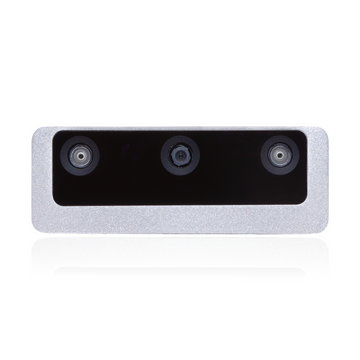OAK-D W PoE
Based on
Connection
Ethernet 1Gbps
Dot projector
No
Infrared
No
IMU
Yes
Sensor 1, 3 - OV9282
Type
Monochrome
DFOV / HFOV / VFOV
Size
1/4
Shutter
Global
Focus
Fixed
Sensor 2 - IMX378
Type
Color
DFOV / HFOV / VFOV
Size
1/2.3
Shutter
Rolling
Focus
Fixed

Stereo
Wide FOV
Looking for more details? Visit specific features at Platform -> Features
RVC2 inside
- 4 TOPS of processing power (1.4 TOPS for AI) - RVC2 NN Performance
- Run any AI model, even custom-architectured/built ones - models need to be converted.
- Encoding: H.264, H.265, MJPEG - 4K/30FPS, 1080P/60FPS
- Computer vision: warp/dewarp, resize, crop via ImageManip node, edge detection, feature tracking. You can also run custom CV functions
- Stereo depth perception with filtering, post-processing, RGB-depth alignment, and high configurability
- Object tracking: 2D and 3D tracking with ObjectTracker node
- On-device programming: Run custom logic/tasks on-device (guide)
Stereo depth perception
- Ideal range: ~70cm - 12m
- MinZ: ~20cm (400P + extended disp), ~40cm (400P OR 800P + extended), ~70cm (800P)
- Median depth accuracy (See these docs for more info):
- below 3.5m: below 2% absolute depth error
- 3.5m - 6.5m: below 4% absolute depth error
- 6.5m - 9m: below 6% absolute depth error
Connectors

| Pin | M12 pin | M8 pin | M8 functionality |
|---|---|---|---|
| 1 | Eth MX0+ | AUX GPIO 3V3 | 3V3 auxiliary GPIO 52. Pull this pin high with 10k resistor at startup for USB boot. |
| 2 | Eth MX0- | FSYNC ISO | Isolated Frame synchronization input signal for cameras |
| 3 | Eth MX1+ | USB D+ | USB 2.0 interface that can be used to connect to the OAK device (eg. reflash) if USB boot is enabled (via AUX GPIO 3V3). |
| 4 | Eth MX1- | USB D- | USB 2.0 interface that can be used to connect to the OAK device (eg. reflash) if USB boot is enabled (via AUX GPIO 3V3). |
| 5 | Eth MX3+ | VBUSIN | This pin is used for sourcing 5V power to accessory devices connected to the M8 connector. If trying to boot the device in USB boot mode, this pin can also sink current. |
| 6 | Eth MX3- | Strobe ISO | Isolated Strobe output signal for cameras (Open Collector) |
| 7 | Eth MX2+ | Isolated GND | Isolated ground for Strobe/FSYNC |
| 8 | Eth MX2- | GND | Ground |

External triggering: Sensors require 1V8 rising edge on FSYNC for the trigger event. We are using an optocoupler and ESD protection diode, so the input trigger voltage should be 12V (up to 24V) and the trigger logic is reversed, so trigger event happens at 0V on the FSYNC line. For an example, see External FSYNC Example.
Power consumption
- Base consumption + PoE circuitry + camera streaming: 3W - 3.5W
- AI subsystem consumption: Up to 1W
- Stereo depth pipeline subsystem: Up to 0.5W
- Video Encoder subsystem: Up to 0.5W
IMU
Due to supply chain issues, most of the OAK camera that were manufactured between Q2 2021 and Q2 2023 have integrated BMI270 - 6-axis IMU instead.
Operating temperature
Vibration Testing
- Vibration Report - Report of the vibration stress tests performed by the SIQ (3rd-party lab)
- Vibration Results - Results of Camera Focus, Camera Angles, and Stereo Depth Accuracy before and after the vibration stress tests
Similar models
OAK-D S2 PoEOAK-D W PoEOAK-D Pro PoEOAK-D Pro W PoE